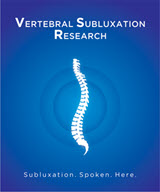Foundation for Vertebral Subluxation Responds to Movement Away from Subluxation Terminology

Recently certain groups within chiropractic that were associated with those who manage vertebral subluxation in a vitalistic and salutogenic model and purported to support them in those efforts have been distancing themselves from the term subluxation.
While attempting to get rid of subluxation terminology is nothing new in the history of chiropractic, what is new are factions within the community of chiropractors that traditionally embraced the term now distancing themselves from it.
We see this in the intellectual sleight of hand used by so called chiropractic researchers who conflate subluxation with "joint dysfunction" and the adjustment with "spinal manipulation" in their published works or do not use subluxation and adjustment terminology at all. Their actions poison the scientific literature with a complete lie about the nature of subluxation that is then used against chiropractors practicing in a subluxation model. Making matters worse some then produce press releases and patient educational material that surreptitiously uses subluxation terms even though they did not use it in the research paper - essentially deceiving chiropractors and the public who never read the full paper.
The excuse given is that the journal they submitted to would not have published the paper unless they changed the terms. This excuse is given despite the fact that research using our unique terminology is published all the time and with the belief that no one will notice or even care.
Another tactic being used to get rid of subluxation terminology is focusing instead on the adjustment itself instead of an operational definition of subluxation. This is done in an effort to unite otherwise disparate groups. Of course this is done without an understanding that absent subluxation as the reason for the adjustment then the so-called adjustment isn't actually an adjustment but a manipulation at best and an assault on the body at worst.
Other attempts to distance themselves from subluxation terminology take the form of switching from terms such as "subluxation based" or "subluxation focused" to "neurologically based" or "neurologically focused" chiropractic. This includes attempts by practice management groups to train chiropractors to move away from subluxation towards a "brain based" patient educational process.
Regardless of the tactics used, or the weakness of the rationales given, these actions move the practice of chiropractic from a unique, non-duplicative philosophy, science and art to one that is practiced by a host of other providers leaving chiropractic without a unique strategic competitive advantage.
These actions, no matter how vigorously defended, support and encourage the factions within chiropractic that seek social and professional acceptance of chiropractic through the abandonment of subluxation. It is done under the mistaken belief that it is the adherence to subluxation that is responsible for the profession's lack of cultural authority.
It is done without understanding (or simple disdain) for the implications on legislative language using subluxation, the scientific implications on the future of the profession and the marketing ramifications for duplicating services already offered by a host of other providers.
The Foundation for Vertebral Subluxation holds that the unique role of the chiropractor is separate from other health disciplines and that the professional practice objective of chiropractors is the analysis, correction or stabilization of the subluxation.
State laws, the federal government, international, national and state chiropractic organizations and the Association of Chiropractic Colleges all define the unique and non-duplicative role and responsibility of chiropractic as focusing particular attention on the subluxation and its resultant compromise of neural integrity.
The use of subluxation as a rationale for care is supported by protocols that are safe, efficacious, and valid. The literature is sufficiently supportive of the usefulness of these protocols in regard to chiropractic examination and analysis.
The chiropractor uses a variety of procedures to assess the vertebral subluxation in order to determine its presence and arrive at an impression of its location, character, type, and chronicity.
Management of subluxation is applicable to any patient exhibiting evidence of its existence regardless of the presence or absence of symptoms and disease and the determination of the presence of subluxation may stand as the sole rationale for care.
Foundation for Vertebral Subluxation
Board of Directors

Blogs
- The Chiropractic Cartel: A Look Back at Bias in Accreditation and its Imact on Today's Profession
- Inside Montana's Chiropractic Monopoly: ACA & MCA's Brazen Board Takeover
- Concerns Grow About Control of the NY State Chiropractic Board by the ACA - Use of X-ray in NY Under Threat
- Reproductive Health Information and Chiropractic Care: Navigating New Privacy Regulations
- Navigating Substance Use Disorder (SUD) Consent: What Chiropractors Need to Know













